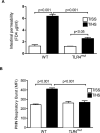Activation of toll-like receptor 4 is necessary for trauma hemorrhagic shock-induced gut injury and polymorphonuclear neutrophil priming
- PMID: 22575992
- PMCID: PMC3378823
- DOI: 10.1097/SHK.0b013e318257123a
Activation of toll-like receptor 4 is necessary for trauma hemorrhagic shock-induced gut injury and polymorphonuclear neutrophil priming
Abstract
Interactions of toll-like receptors (TLRs) with nonmicrobial factors play a major role in the pathogenesis of early trauma-hemorrhagic shock (T/HS)-induced organ injury and inflammation. Thus, we tested the hypothesis that TLR4 mutant (TLR4 mut) mice would be more resistant to T/HS-induced gut injury and polymorphonuclear neutrophil (PMN) priming than their wild-type littermates and found that both were significantly reduced in the TLR4 mut mice. In addition, the in vivo and ex vivo PMN priming effect of T/HS intestinal lymph observed in the wild-type mice was abrogated in TLR4 mut mice as well the TRIF mut-deficient mice and partially attenuated in Myd88 mice, suggesting that TRIF activation played a more predominant role than MyD88 in T/HS lymph-induced PMN priming. Polymorphonuclear neutrophil depletion studies showed that T/HS lymph-induced acute lung injury was PMN dependent, because lung injury was totally abrogated in PMN-depleted animals. Because the lymph samples were sterile and devoid of endotoxin or bacterial DNA, we investigated whether the effects of T/HS lymph was related to endogenous nonmicrobial TLR4 ligands. High-mobility group box 1 protein 1, heat shock protein 70, heat shock protein 27, and hyaluronic acid all have been implicated in ischemia-reperfusion-induced tissue injury. None of these "danger" proteins appeared to be involved, because their levels were similar between the sham and shock lymph samples. In conclusion, TLR4 activation is important in T/HS-induced gut injury and in T/HS lymph-induced PMN priming and lung injury. However, the T/HS-associated effects of TLR4 on gut barrier dysfunction can be uncoupled from the T/HS lymph-associated effects of TLR4 on PMN priming.
Figures





References
-
- Matzinger P. The danger model: A renewed sense of self. Science. 2002;296:301–305. - PubMed
-
- Bianchi ME. Damps, pamps and alarmins: All we need to know about danger. J Leukoc Biol. 2007;81:1–5. - PubMed
-
- Paterson HM, Murphy TJ, Purcell EJ, Shelley O, Kriynovich SJ, Lien E, Mannick JA, Lederer JA. Injury primes the innate immune system for enhanced toll-like receptor reactivity. J Immunol. 2003;171:1473–1483. - PubMed
-
- Mollen K, Anand R, Tsung A, Prince J, Levy R, Billiar T. Emerging paradigm: Toll-like receptor 4-sentinel for the detection of tissue damage. Shock. 2006;26:430–437. - PubMed
Publication types
MeSH terms
Substances
Grants and funding
LinkOut - more resources
Full Text Sources
Research Materials

